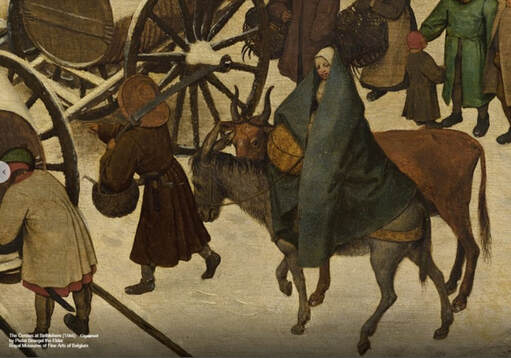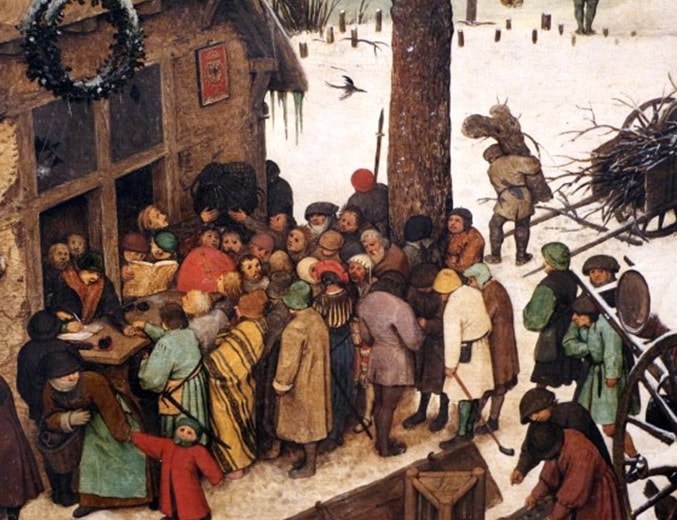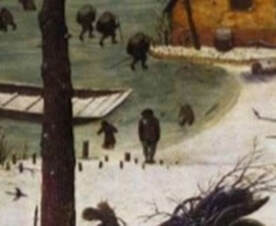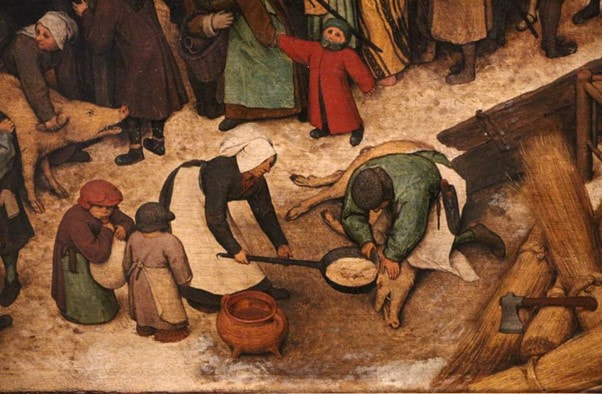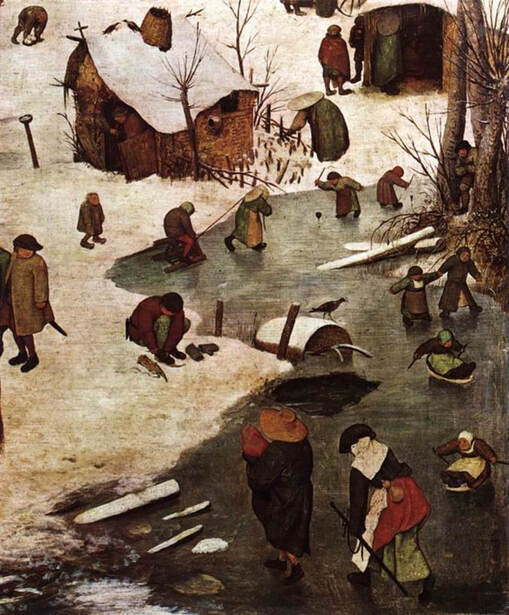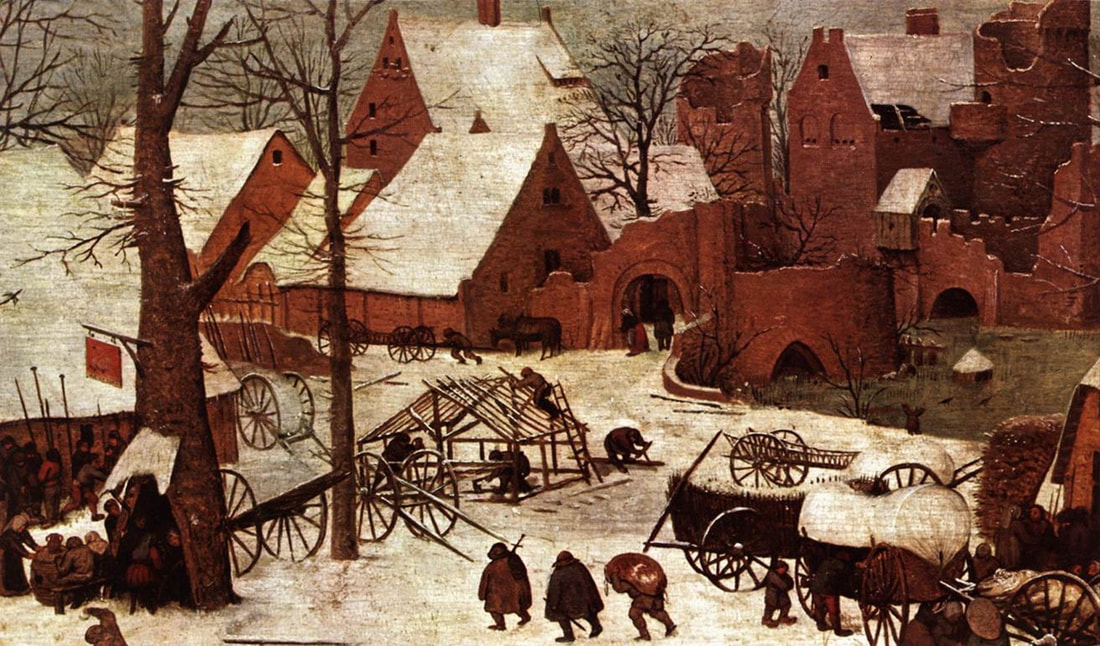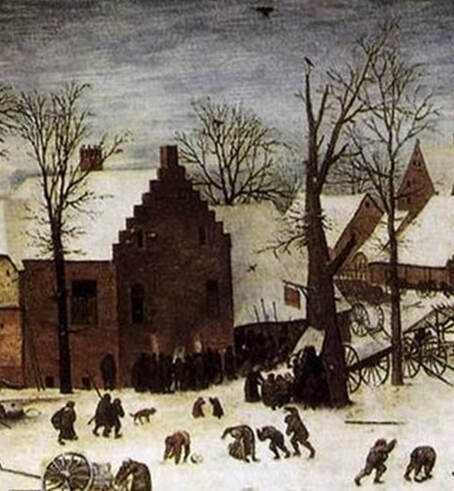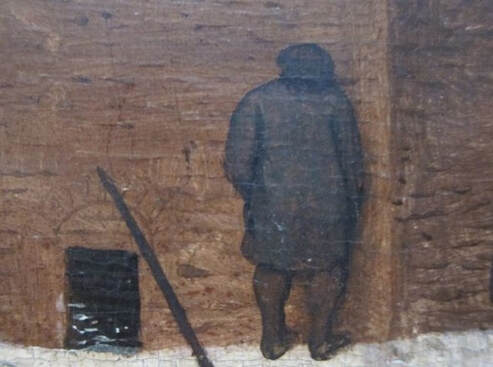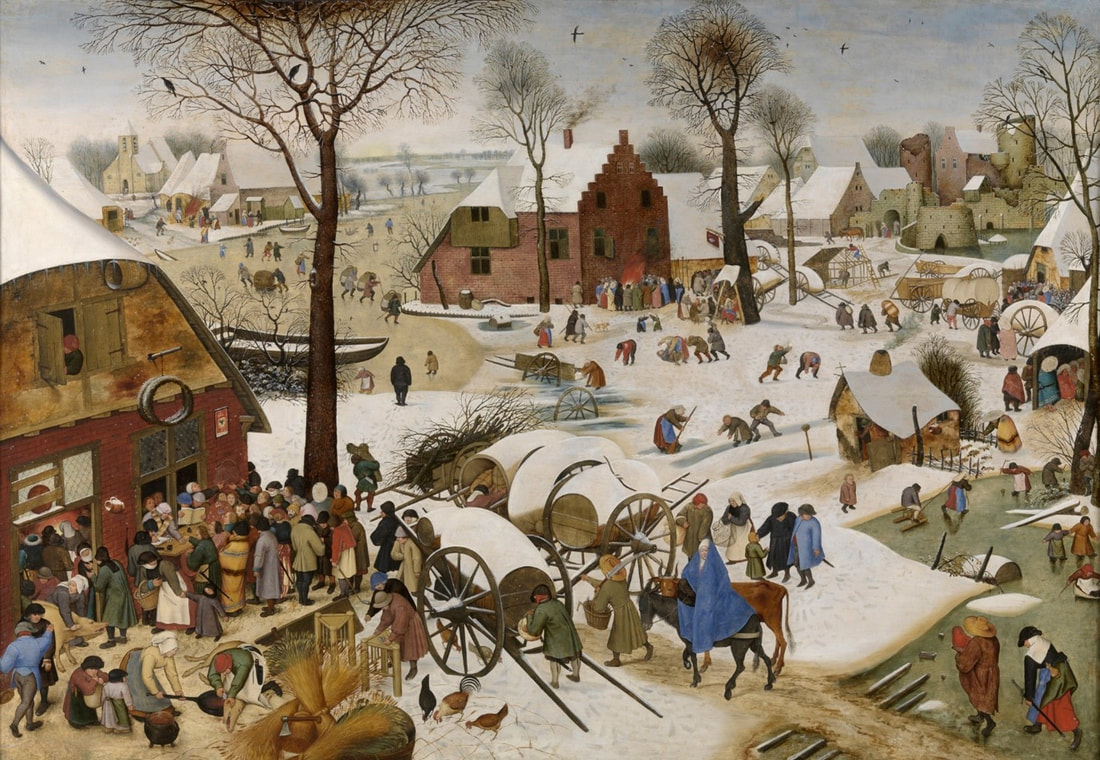Bruegel’s White Christmas:
The Census at Bethlehem
By Philip McCouat For comments on this article, see here
Introduction
|
It’s probably the very first painting of a White Christmas. It depicts as many as 200 individuals, but hides its principal characters, and gives us an intimate look at everyday life in a 16th century village.
It’s Pieter Bruegel the Elder’s masterpiece The Census at Bethlehem. |
For more on Bruegel
|
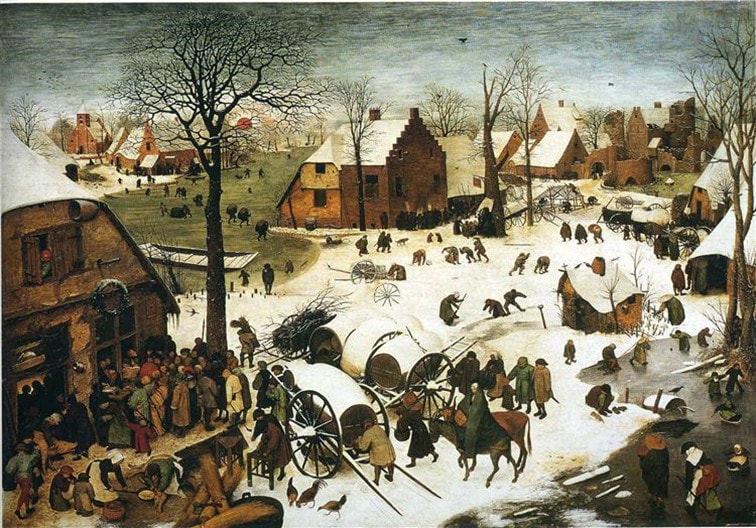 Fig 1: Pieter Bruegel the Elder, The Census at Bethlehem (1566), Oil on panel, 116 cm x 164 cm, Royal Museums of Fine Arts of Belgium, Brussels. Also known as the Numbering at Bethlehem.
Fig 1: Pieter Bruegel the Elder, The Census at Bethlehem (1566), Oil on panel, 116 cm x 164 cm, Royal Museums of Fine Arts of Belgium, Brussels. Also known as the Numbering at Bethlehem.
Essentially, we are looking at three paintings in one here – a religious painting, a snowy landscape, and a genre scene of everyday life [1]. And added to this, there is possibly a fourth – a propaganda painting. In this article we’ll examine all these aspects, and see how Bruegel subtly knits them seamlessly together into a unified whole.
#1 A relocated Biblical scene
The religious element of the painting, and the painting’s pivotal episode, take place in the mid foreground. An inconspicuous Mary and Joseph appear to be just arriving (Fig 2). Mary, pregnant, in a long blue cloak, with her face partly revealed, is seated on a donkey, with an accompanying ox by her side, who has turned its head to look directly at the viewer [2]. The donkey is being led by Mary’s espoused husband, the brown-clad Joseph, carrying a long carpenter’s saw on his shoulder, with his back to the viewer. He is threading his way between two wagons laden with large beer casks. Apart from the fact that Mary and Joseph are evidently visitors, there is little indication -- by halo, colouring, size or otherwise -- to distinguish them from the rest of the crowd.
#1 A relocated Biblical scene
The religious element of the painting, and the painting’s pivotal episode, take place in the mid foreground. An inconspicuous Mary and Joseph appear to be just arriving (Fig 2). Mary, pregnant, in a long blue cloak, with her face partly revealed, is seated on a donkey, with an accompanying ox by her side, who has turned its head to look directly at the viewer [2]. The donkey is being led by Mary’s espoused husband, the brown-clad Joseph, carrying a long carpenter’s saw on his shoulder, with his back to the viewer. He is threading his way between two wagons laden with large beer casks. Apart from the fact that Mary and Joseph are evidently visitors, there is little indication -- by halo, colouring, size or otherwise -- to distinguish them from the rest of the crowd.
So why are Mary and Joseph in Bethlehem, when their hometown was Nazareth? According to the Biblical account (Luke 2: 1-5), they left their home in Nazareth because of a decree from Caesar Augustus that “all the [Roman] world be taxed” in their “own city”. They have come to Bethlehem, “the city of David”, because they are required to register and pay tax there, as Joseph was of David’s “house and lineage”. And it is there, after failing to get a bed at the inn – not surprising in view of the crowds -- that Jesus will shortly be born in a stable [3].
It is of course obvious that although the painting is titled The Census at Bethlehem, it is not in fact set there. Bruegel, as he has done in other paintings [4], has instead depicted the Biblical scene as a contemporary event, and relocated it from Biblical Palestine to 16th-century northern Europe. This switch, creating a deliberate anachronism, requires us to accept an internal contradiction -- the villagers are about to witness an impending event -- the birth of Christ -- that actually occurred one and a half millennia before.
#2 The birth of the snowy landscape
This painting is one of a number of snowy winter pictures that Bruegel painted within an extremely short period, including Hunters in the Snow, The Adoration of the Magi in the Winter, The Massacre of the Innocents and Winter landscape with Skaters and Bird Trap. It is quite probable that the snowy setting in each was inspired by the recent extraordinarily severe winter of 1564-65 that created such hardship in the Netherlands and the rest of Europe that it is often credited as giving rise to the “Little Ice Age” [5]. In fact, Bruegel could justly claim credit for being the first to popularise the now-familiar genre of the snowy winter scene.
The Census itself can also claim two further “firsts”-- it is apparently the first depiction of a “White Christmas” in art; it is also, rather surprisingly, apparently one of the first times that any painter has tackled this particular Biblical episode of the Census [6], despite the fact that this incident plays such a pivotal role in the Christmas story.
#3 The myriad details of village life
The painting is also a genre scene of life in a Flemish village some 450 years ago. It teems with different characters (about 200 of them!) and activities [7]. Through the bare branches of the tall tree at the left of the painting, we can see a red sun setting in the distance, above the frozen pond. The scene is alive with activity – a crowd gathers, children play, men drink and villagers carry out their daily chores.
Compositionally, from an elevated position, the viewer’s eye is drawn to the lower left corner, where there is the densest activity round the inn, then alights on Mary and Joseph, then curves round to the upper right, then follows the activity back across the buildings at the top of the painting, back to the inn. So, let us follow this route to see what is going on.
The gathering at the inn
In the lower left of the painting, outside an inn identified by its sign as ‘The Green Wreath’, a crowd of people, bundled up against the cold, has gathered to register and to pay their taxes (Fig 3), watched by an interested spectator poking his head out of an upstairs shuttered window. At the inn door, a scribe sitting at a table records the villagers’ details, and an official with a fur-collared coat collects their money. Notable among the crowd is a man wearing an exotic, striped yellow outfit, probably North African, interesting because similar figures appear in other of Bruegel’s works, such as the Conversion of Saul and Sermon of St John the Baptist [8].
It is of course obvious that although the painting is titled The Census at Bethlehem, it is not in fact set there. Bruegel, as he has done in other paintings [4], has instead depicted the Biblical scene as a contemporary event, and relocated it from Biblical Palestine to 16th-century northern Europe. This switch, creating a deliberate anachronism, requires us to accept an internal contradiction -- the villagers are about to witness an impending event -- the birth of Christ -- that actually occurred one and a half millennia before.
#2 The birth of the snowy landscape
This painting is one of a number of snowy winter pictures that Bruegel painted within an extremely short period, including Hunters in the Snow, The Adoration of the Magi in the Winter, The Massacre of the Innocents and Winter landscape with Skaters and Bird Trap. It is quite probable that the snowy setting in each was inspired by the recent extraordinarily severe winter of 1564-65 that created such hardship in the Netherlands and the rest of Europe that it is often credited as giving rise to the “Little Ice Age” [5]. In fact, Bruegel could justly claim credit for being the first to popularise the now-familiar genre of the snowy winter scene.
The Census itself can also claim two further “firsts”-- it is apparently the first depiction of a “White Christmas” in art; it is also, rather surprisingly, apparently one of the first times that any painter has tackled this particular Biblical episode of the Census [6], despite the fact that this incident plays such a pivotal role in the Christmas story.
#3 The myriad details of village life
The painting is also a genre scene of life in a Flemish village some 450 years ago. It teems with different characters (about 200 of them!) and activities [7]. Through the bare branches of the tall tree at the left of the painting, we can see a red sun setting in the distance, above the frozen pond. The scene is alive with activity – a crowd gathers, children play, men drink and villagers carry out their daily chores.
Compositionally, from an elevated position, the viewer’s eye is drawn to the lower left corner, where there is the densest activity round the inn, then alights on Mary and Joseph, then curves round to the upper right, then follows the activity back across the buildings at the top of the painting, back to the inn. So, let us follow this route to see what is going on.
The gathering at the inn
In the lower left of the painting, outside an inn identified by its sign as ‘The Green Wreath’, a crowd of people, bundled up against the cold, has gathered to register and to pay their taxes (Fig 3), watched by an interested spectator poking his head out of an upstairs shuttered window. At the inn door, a scribe sitting at a table records the villagers’ details, and an official with a fur-collared coat collects their money. Notable among the crowd is a man wearing an exotic, striped yellow outfit, probably North African, interesting because similar figures appear in other of Bruegel’s works, such as the Conversion of Saul and Sermon of St John the Baptist [8].
The official nature of the proceedings is reinforced by the presence of the small red and yellow sign, with the Habsburg imperial double eagle, on the inn wall, close to the red-hatted, spear-carrying guard standing next to the tree [9]. As we shall see later, this is possibly a sly dig at the association of the Habsburgs for the onerous crippling taxes they were enforcing against the Flemish. Near the guard, a man is loading a wagon of sticks, maybe to be used as firewood.
|
To the right of him, another man stands motionless at the edge of the frozen ice, the smudge of a previously-thrown snowball still just visible on his shoulder (Fig 4). In the lower left corner of the painting (Fig 5), woman is grasping a pig's ears as she leads it out to a butcher who is already slaughtering another, its blood being caught by the bending woman holding a pan. It will probably be fried in hot fat [10] or made into sausages, or even be intended as a payment of taxes in kind.
|
Of course, in the real Jewish town of Bethlehem, pork would have been prohibited [11], but it was a popular luxury in the Netherlands, and it can even be seen as a metaphor for the peasants being bled dry by excessive taxes levied by their Spanish overlords. Straw is being laid out for the flesh to be singed. Two children, one of them inflating a pig’s bladder for skimming on the ice, watch the proceedings. A beehive fixed under the eaves of the house (see Fig 1) is being used as a birds’ nest, possibly in the hope of collecting eggs or the birds themselves. On the ground, chickens peck hopefully.
Children’s games and village life
In the foreground on the right of the painting, children play on the ice, using sleds made from improvised cow jaw bones (Fig 6). In one vignette, a boy on an overturned three-legged stool is being pulled across the ice, while a third smaller child watches on, shivering. Just beyond them, two children spin tops on the ice. At the far right, an older child assists a toddler to skate, and two girls on sleds use sticks to scud across the ice. A man crouches at the edge of the pond, tying on his skates. Near him, a peasant in a blue cloak greets a red-hatted child, and two others carry baskets, probably with poultry inside. In the lower right corner, a pair of pilgrims enter the scene, unwittingly following the trail of Mary and Joseph.
In the foreground on the right of the painting, children play on the ice, using sleds made from improvised cow jaw bones (Fig 6). In one vignette, a boy on an overturned three-legged stool is being pulled across the ice, while a third smaller child watches on, shivering. Just beyond them, two children spin tops on the ice. At the far right, an older child assists a toddler to skate, and two girls on sleds use sticks to scud across the ice. A man crouches at the edge of the pond, tying on his skates. Near him, a peasant in a blue cloak greets a red-hatted child, and two others carry baskets, probably with poultry inside. In the lower right corner, a pair of pilgrims enter the scene, unwittingly following the trail of Mary and Joseph.
Beyond the frozen pond, there is a tumbledown hut. On its roof an old basket without a bottom has been turned upside down to make a chimney [12]. Someone looks to be tending or pilfering items in the snowy garden at the back of the hut. The hut’s distance from the others suggests that it houses a leper (or plague victim), who appears at the door begging, holding the characteristic leper’s clapper. A spindly cross on the gable suggests that the inhabitant depends on alms.
Just across from the hut, a boy is tripping up another, and behind them, children are scuffling and throwing snowballs at each other. Some villagers, clustered at a wagon, appear to be having their palms read as others load bags of grain. Further out, in front of a partly-ruined moated castle, men with wagons are constructing a new timber building. The poor state of the castle has been variously proposed as a symbol of the passing of the feudal era – serfdom had been abolished in the Netherlands during the 16th century -- or as reflecting the uncertain political situation at the time Bruegel was painting; or even as a symbol of declining heathendom in the face of the coming of Christianity [13]. At the edge of the moat a small child is waving its arms, apparently to scare off the birds.
Just across from the hut, a boy is tripping up another, and behind them, children are scuffling and throwing snowballs at each other. Some villagers, clustered at a wagon, appear to be having their palms read as others load bags of grain. Further out, in front of a partly-ruined moated castle, men with wagons are constructing a new timber building. The poor state of the castle has been variously proposed as a symbol of the passing of the feudal era – serfdom had been abolished in the Netherlands during the 16th century -- or as reflecting the uncertain political situation at the time Bruegel was painting; or even as a symbol of declining heathendom in the face of the coming of Christianity [13]. At the edge of the moat a small child is waving its arms, apparently to scare off the birds.
At the hollow tree, in front of the solid building with the stepped gables (possibly a merchant’s country house), is a makeshift bar where men are drinking (Fig 8). A red sign with a depiction of a swan hangs from a branch. At the very top of the tree sits a crow. People, including some off-duty guards with spears, huddle round a nearby brushwood fire.
Hollow trees and crows could sometimes be symbolic of dissolution [14], so it is probably significant that Bruegel chooses to also depict here a man urinating against a wall of the building (Fig 9).
In the very centre of the painting, a wagon appears to have collapsed, leaving the two wheels prominent. They are sometimes rather imaginatively interpreted as the wheels of fortune or as representing the cyclical nature of things, or as a sign of chaos [15].
Finally, at the top far left, directly beyond the Green Wreath Inn, we see a church, conspicuously clean and well-ordered, possibly symbolising the beneficial influence of religion in contrast to the crumbling secular castle [16].
A much-copied painting
No less than 14 copies of the painting are known to exist [17] and all of them are by Bruegel’s son, Pieter Brueghel the Younger [18]. The son was born very shortly before his father died, so would hardly had known him, but he built up a solid reputation and a prosperous living by doing and selling copies of his father’s works, in addition to his own works. These copies were almost slavishly direct, subject to some quite subtle changes of detail. Identifying these differences provides us with some insights into what made the original so distinctive [19].
Finally, at the top far left, directly beyond the Green Wreath Inn, we see a church, conspicuously clean and well-ordered, possibly symbolising the beneficial influence of religion in contrast to the crumbling secular castle [16].
A much-copied painting
No less than 14 copies of the painting are known to exist [17] and all of them are by Bruegel’s son, Pieter Brueghel the Younger [18]. The son was born very shortly before his father died, so would hardly had known him, but he built up a solid reputation and a prosperous living by doing and selling copies of his father’s works, in addition to his own works. These copies were almost slavishly direct, subject to some quite subtle changes of detail. Identifying these differences provides us with some insights into what made the original so distinctive [19].
One of Brueghel the Younger’s versions is shown in Fig 10. This version, like many of his other copies, is cleaner, brighter, blander and more picturesque than Bruegel’s original. The setting is earlier in the day (the setting sun has been omitted), so the sky is not so threatening, and everything is lighter. It is not as barren, as the trees have been given more foliage, and a leafy bush has been added behind the leper’s hut. Birds have been added to the tree at left. The temperature does not seem as cold,
While Bruegel’s palette of ochres, whites, browns and grey-greens still predominates, Mary is made more prominent, with a brighter blue robe, and various other figures in the composition are picked out more clearly by blues and reds. The town has been tidied up and slightly simplified – the original’s slushy ice in the right foreground has been replaced by a clean, neat walkway, and the man sitting to put his skates on has been omitted; the distant church grouping at upper left has been brought closer; the buildings are cleaner, as is the snow, which has lost much of Bruegel’s well-observed shadings, and is more uniform in colour. A homely wisp of smoke has been added to the large house’s chimney. In short, the copy has sanitised the realistic grit of the original, and replaced it with a more prettified, softer version.
#4 Wider implications; a propaganda piece?
As with many works by Bruegel, his Census can be interpreted in various ways.
Bruegel’s relocation of the Biblical event into a more contemporary setting can be seen simply as a way of enabling his audience to more easily identify with that event. There were in fact some significant parallels between the social and political circumstances in both 16th-century Flanders and Palestine at the time of Christ’s birth. Both were ruled by foreign militaristic dictatorships – Flanders by Spain, and Palestine by Rome. In both, those foreign powers exacted heavy taxes. In both, the local populations were oppressed -- Rome suppressed opposition just as Spain’s emissaries executed rebellious Flemings [20]. And in both, there were violent religious differences – Rome attacked the adherents of the new Christian religion, and Spain, as “defender of the Catholic faith” attacked the adherents of the emerging new Protestant church.
Bruegel, and his audience, were well aware of these parallels, and it seems very likely that the subject of the painting was deliberately chosen to exploit them. Bruegel’s placing of the red coat of arms of the Habsburgs on the wall of the inn, just next to the tax collectors (Fig 3), makes the connection quite specific.
Does Bruegel play with these parallels in order to encourage his audience to be more optimistic, by seeing that a joyous Biblical event is depicted as taking place in their own environment, despite their own extremely difficult circumstances? Or, as many argue, is he intending to make the audience more resentful about the hated and oppressive Spanish rule? It is even possible to argue that he is doing precisely the opposite ~ endorsing the Spanish rule by identifying it with the Biblical story [21]. As so often is the case, Bruegel leaves it open for each generation to draw their own conclusions.
While Bruegel’s palette of ochres, whites, browns and grey-greens still predominates, Mary is made more prominent, with a brighter blue robe, and various other figures in the composition are picked out more clearly by blues and reds. The town has been tidied up and slightly simplified – the original’s slushy ice in the right foreground has been replaced by a clean, neat walkway, and the man sitting to put his skates on has been omitted; the distant church grouping at upper left has been brought closer; the buildings are cleaner, as is the snow, which has lost much of Bruegel’s well-observed shadings, and is more uniform in colour. A homely wisp of smoke has been added to the large house’s chimney. In short, the copy has sanitised the realistic grit of the original, and replaced it with a more prettified, softer version.
#4 Wider implications; a propaganda piece?
As with many works by Bruegel, his Census can be interpreted in various ways.
Bruegel’s relocation of the Biblical event into a more contemporary setting can be seen simply as a way of enabling his audience to more easily identify with that event. There were in fact some significant parallels between the social and political circumstances in both 16th-century Flanders and Palestine at the time of Christ’s birth. Both were ruled by foreign militaristic dictatorships – Flanders by Spain, and Palestine by Rome. In both, those foreign powers exacted heavy taxes. In both, the local populations were oppressed -- Rome suppressed opposition just as Spain’s emissaries executed rebellious Flemings [20]. And in both, there were violent religious differences – Rome attacked the adherents of the new Christian religion, and Spain, as “defender of the Catholic faith” attacked the adherents of the emerging new Protestant church.
Bruegel, and his audience, were well aware of these parallels, and it seems very likely that the subject of the painting was deliberately chosen to exploit them. Bruegel’s placing of the red coat of arms of the Habsburgs on the wall of the inn, just next to the tax collectors (Fig 3), makes the connection quite specific.
Does Bruegel play with these parallels in order to encourage his audience to be more optimistic, by seeing that a joyous Biblical event is depicted as taking place in their own environment, despite their own extremely difficult circumstances? Or, as many argue, is he intending to make the audience more resentful about the hated and oppressive Spanish rule? It is even possible to argue that he is doing precisely the opposite ~ endorsing the Spanish rule by identifying it with the Biblical story [21]. As so often is the case, Bruegel leaves it open for each generation to draw their own conclusions.
conclusion
For all that, for me in the 21st century, the main feature in this painting is its projection of sheer humanity. Observing the painting’s numerous self-contained vignettes of ordinary life, as it was experienced almost than half a millennium ago, it is impossible not to be struck by the continuity of the things that we value and the things that challenge us – a love of play, an appreciation of the importance of labour, the temptation of indulgence, the inspiration of hope, the unwelcome inevitably of paying taxes, the need for resistance to tyranny -- or just the peaceful pleasures of pottering around ■
© Philip McCouat 2021
First published February 2021
This article may be cited as Philip McCouat, “Bruegel’s White Christmas: The Census at Bethlehem” Journal of Art in Society, http://www.artinsociety.com
Your comments on this article are welcomed
RETURN TO HOME
© Philip McCouat 2021
First published February 2021
This article may be cited as Philip McCouat, “Bruegel’s White Christmas: The Census at Bethlehem” Journal of Art in Society, http://www.artinsociety.com
Your comments on this article are welcomed
RETURN TO HOME
end notes
[1] Museum Van Den Burgh, “The Census at Bethlehem” https://www.museummayervandenbergh.be/en/page/census-bethlehem
[2] A donkey and ox are traditionally depicted in Nativity scenes
[3] It appears that there is very little non-Biblical evidence that Augustus did in fact decree an Empire-wide census in which everyone had to return to their “own city”: Bart D. Ehrman, Jesus, Interrupted: Revealing the Hidden Contradictions in the Bible & Why We Don’t Know About Them, Harper Collins, 2009
[4] For example, The Way to Calvary
[5] Alexander Wied, Bruegel (transl Anthony Lloyd), Bay Books, Sydney 1980, at 146; see further discussion in our article on Hunters in the Snow
[6] Wied, op cit at 144
[7] Many of the extreme close-ups of the painting that are used in this article are drawn from Google Arts and Culture https://artsandculture.google.com/exhibit/the-census-at-bethlehem-%C2%A0/zQKyGcrY3z1hKQ]; and Ginny Burges, https://rhapsodyinwords.com/2018/12/24/whats-in-a-painting-taking-a-closer-look-at-pieter-bruegel-the-elders-masterpiece-the-census-at-bethlehem-c-1566/
[8] Wied, op cit at 144
[9] Wied, op cit at 144
[10] Wied, op cit at 144
[11] Rose-Marie and Rainer Hagen, chapter “A Village in Winter”, What Great Paintings Say. Vol 2, Taschen, Cologne, 2003, at 186
[12] Hagen, op cit at 184
[13] Wied, op cit at 144-45. It’s also been suggested, by the way, that the structure is possibly based on the towers and gate of Amsterdam Castle
[14] Hagen, op cit at 84
[15] It is interesting how many spoked wheels appear in the painting
[16] Wied, op cit at 144
[17] The 14th was only discovered in 2013: Jan Dalley: “Pieter Breughel the Younger: The Census at Bethlehem”, Financial Times, 12/10/2013 https://www.ft.com/content/20ac37e8-30da-11e3-b991-00144feab7de
[18] In association with members of his studio. His surname was by then being spelt with an “h”
[19] It is also possible that some differences emerged because the son may only have had access to Bruegel’s preparatory sketches, not the original painting
[20] Timothy Foote, The World of Bruegel: 1525-1569, Time- Life International (Nederland) NV, 1971 at 104
[21] See Jacques Keilo, “The coat of arms of the Empire in Bruegel’s Census at Bethlehem, Continuity of the Centre” in Hypotheses, 23/11/2016 https://centrici.hypotheses.org/1000
© Philip McCouat 2021
RETURN TO HOME
[2] A donkey and ox are traditionally depicted in Nativity scenes
[3] It appears that there is very little non-Biblical evidence that Augustus did in fact decree an Empire-wide census in which everyone had to return to their “own city”: Bart D. Ehrman, Jesus, Interrupted: Revealing the Hidden Contradictions in the Bible & Why We Don’t Know About Them, Harper Collins, 2009
[4] For example, The Way to Calvary
[5] Alexander Wied, Bruegel (transl Anthony Lloyd), Bay Books, Sydney 1980, at 146; see further discussion in our article on Hunters in the Snow
[6] Wied, op cit at 144
[7] Many of the extreme close-ups of the painting that are used in this article are drawn from Google Arts and Culture https://artsandculture.google.com/exhibit/the-census-at-bethlehem-%C2%A0/zQKyGcrY3z1hKQ]; and Ginny Burges, https://rhapsodyinwords.com/2018/12/24/whats-in-a-painting-taking-a-closer-look-at-pieter-bruegel-the-elders-masterpiece-the-census-at-bethlehem-c-1566/
[8] Wied, op cit at 144
[9] Wied, op cit at 144
[10] Wied, op cit at 144
[11] Rose-Marie and Rainer Hagen, chapter “A Village in Winter”, What Great Paintings Say. Vol 2, Taschen, Cologne, 2003, at 186
[12] Hagen, op cit at 184
[13] Wied, op cit at 144-45. It’s also been suggested, by the way, that the structure is possibly based on the towers and gate of Amsterdam Castle
[14] Hagen, op cit at 84
[15] It is interesting how many spoked wheels appear in the painting
[16] Wied, op cit at 144
[17] The 14th was only discovered in 2013: Jan Dalley: “Pieter Breughel the Younger: The Census at Bethlehem”, Financial Times, 12/10/2013 https://www.ft.com/content/20ac37e8-30da-11e3-b991-00144feab7de
[18] In association with members of his studio. His surname was by then being spelt with an “h”
[19] It is also possible that some differences emerged because the son may only have had access to Bruegel’s preparatory sketches, not the original painting
[20] Timothy Foote, The World of Bruegel: 1525-1569, Time- Life International (Nederland) NV, 1971 at 104
[21] See Jacques Keilo, “The coat of arms of the Empire in Bruegel’s Census at Bethlehem, Continuity of the Centre” in Hypotheses, 23/11/2016 https://centrici.hypotheses.org/1000
© Philip McCouat 2021
RETURN TO HOME
